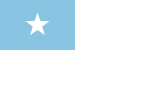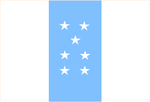Flag of Ecuador
| Flag of Ecuador | |
|---|---|
 |
|
| Vexillological symbol : |
|
| Aspect ratio: | 2: 3 |
| Officially accepted: | November 7, 1900 modified in November 2009 |
The flag of Ecuador has been in continuous use since September 26, 1860, and officially adopted since November 7, 1900.
Description and meaning
The national flag has three horizontal colored stripes. The top strip is twice as high as each of the bottom two. Arranged from top to bottom in gold, blue and red, they form the flag background. In the middle of the flag the condor holds the national coat of arms . According to most sources, the aspect ratio of the national flag is 1: 2, only the naval war flag has had the aspect ratio 2: 3 since the 1980s. However, this information is historical and has never been legally established. In 2009, a government agency set the aspect ratio for all forms of the national flag to 2: 3 for the first time on the President's website.
Gold symbolizes the wealth of Ecuador, blue the beauty of the nature of Ecuador, the sky and the ocean and red the republican freedom and independence and the blood that was shed for it. Variations of these three colors also lead the brother countries of Ecuador, Colombia and Venezuela in their respective flags; they are the colors of Greater Colombia ( Gran Colombia ), which collapsed in 1830.
The components of the coat of arms of Ecuador symbolize:
- Condor : strength and courage
- Landscape: Chimborazo and Río Guayas
- Boat (the "guayas") with a caduceus as a mast: unity and trade
- Golden Sun: Pre-Columbian tradition
- The four signs of the zodiac: The four months of the March Revolution of 1845, which led to the overthrow of President Juan José Flores .
- Palm tree and bay leaves: peace and dignity
- Bundle of Rods : Republican Power
history
On August 10, 1809, "patriots" put a red flag on a white pole as a sign against the Spanish colonial rulers. The uprising resulted in the first proclamation of an independent state, Quito , but by 1816 the country was again under Spanish control. In 1820 a new uprising broke out against the Spaniards. In October, independence fighters put a flag with five stripes in white and blue and three white stars, which stood for Guayaquil , Portoviejo and Machala . In May 1822, what is now Ecuador as part of Greater Colombia became independent from Spain. The national flag became the tricolor in gold, blue and red that is still in use today . On June 2, 1822, a new flag was introduced for the Free Province of Guayaquil : white with a blue jack and a white star, but the flag was restored on June 13 overtaken and replaced by the Greater Colombian tricolor. Greater Colombia collapsed in 1830. The now independent Ecuador kept the tricolor in use until 1845.
2: 3 ? October 1820 to May 25, 1822

2: 3 ? Greater Colombia (flag from 1821)

16:25 ? Free Province of Guayaquil within Greater Colombia, June 2-13, 1822

 ? After the collapse of Greater Colombia May 13, 1830
? After the collapse of Greater Colombia May 13, 1830
The change from the three-colored flag, based on the flag of Greater Colombia, to the blue-white-blue combination that can also be found in other South American states (e.g. the flag of Argentina ) took place after the so-called liberal March Revolution from March 6 to June 17, 1845, which began with the surrender of President General Juan José Flores ended. On November 6, 1845, the number of stars was increased from three to seven. The seven stars symbolized the provinces of the republic. The flag of war also carried the national coat of arms below the stars. However, there are various details about the position of the stars. The information situation became problematic at the end of the 1950s, when there were four governments in Ecuador at the same time. This also explains the extremely different information on the national flag of Ecuador at this time in various historical sources. The yellow-blue-red tricolor can also be found here. In 1858, nine stars appear on the white-blue-white flag.
After the victory of the clerical-conservative Gabriel García Moreno against the liberal party in the national crisis of 1859/60, he made the tricolor the national flag of Ecuador by decree of September 26, 1860. It was finally confirmed by the legislature with the conventions of 1861 and 1900. On December 5, 1900, the state coat of arms in its current version was introduced.
11:16 ? After the March Revolution, from March 6, 1845

2: 3 ? November 6, 1845


 ? November 6, 1845
? November 6, 1845
2: 3 ? November 6, 1845


2: 3 ? War flag November 6th 1845

11:16 ? 1858 (briefly)

Subnational flag
Provinces and cantons of Ecuador have their own flags. Here are a few examples. The flag used by the canton and municipality of Guayaquil and its province of Guayas is striking . It is the historic flag of Ecuador from 1820.
Canton of Quito
Santo Domingo de los Tsáchilas province
Cañar Province
More flags of Ecuador
In addition to the flag with the national coat of arms, the law of 1900 also lists a civil flag consisting only of the tricolor. Nevertheless, most Ecuadorians use the flag with the national coat of arms because their national flag differs from that of Colombia only in the aspect ratio (2: 3).
The Gösch the Navy is a blue flag with an armature and a condor.
The presidential standard corresponds to the national flag with an aspect ratio of 1: 1.
2: 3 ? Civic flag


Individual evidence
- ^ Flags of the World - Ecuador
- ↑ a b Description and specifications for the use of the flag and coat of arms on the President's site ( Memento of the original from July 17, 2010 in the Internet Archive ) Info: The archive link was automatically inserted and not yet checked. Please check the original and archive link according to the instructions and then remove this notice. (Spanish)
literature
- Smith / Neubecker: coats of arms and flags of all nations. Munich 1981, ISBN 3-87045-183-1 .
Web links
- Flags of the World - Ecuador (English)




















